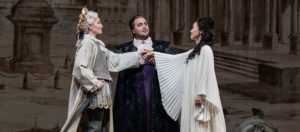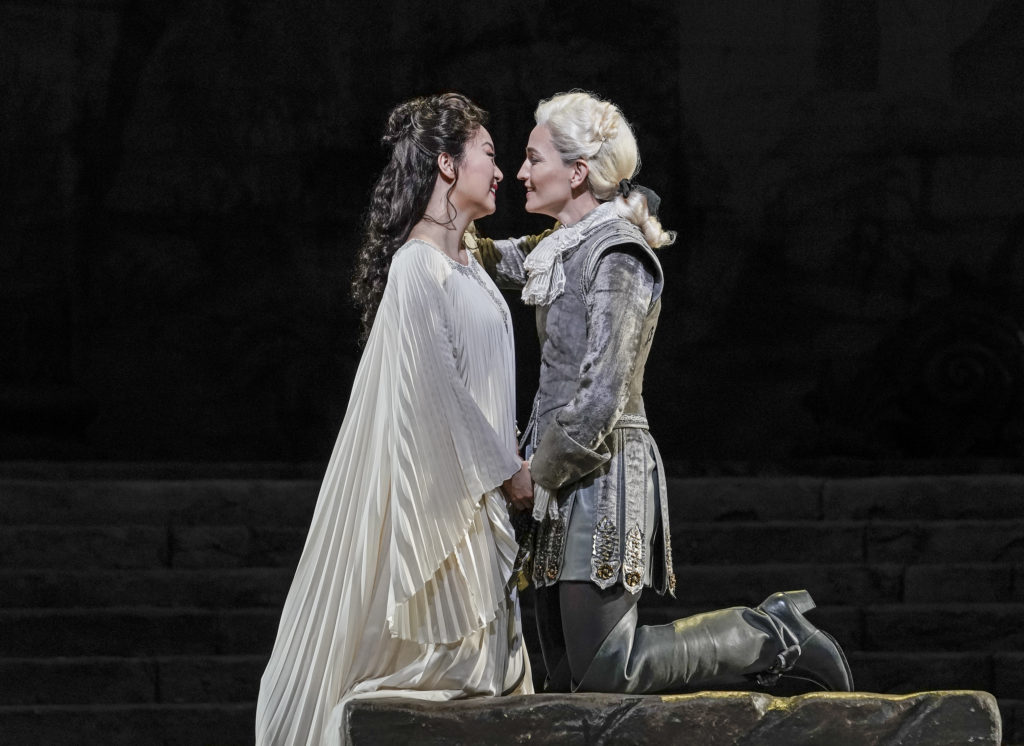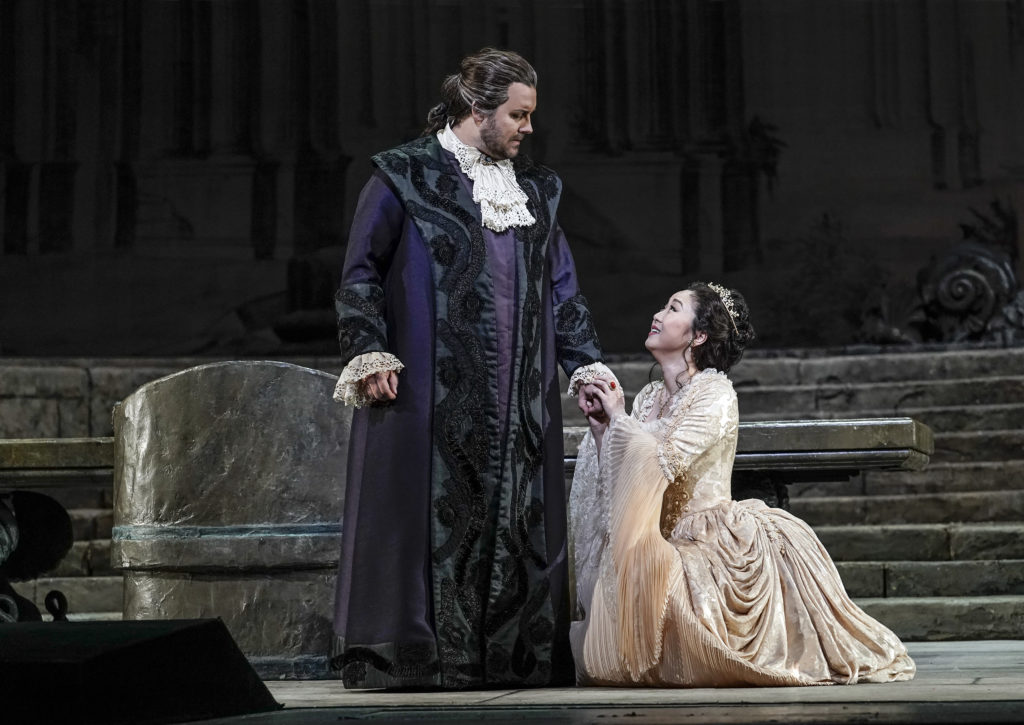
Metropolitan Opera 2022-23 Review: Idomeneo
Michael Spyres, Federica Lombardi, Ying Fang, Kate Lindsey Are Stellar in Mozart Revival
By David Salazar
For the second straight night, the Metropolitan Opera orchestra was at its peak level.
After an incredibly immersive opening night performing in Cherubini’s “Medea,” the ensemble, under the musical direction of Manfred Honeck nearly outdid itself.
From the thunderous overture all the way to the final triumphant march, Honeck had the ensemble surging forward with unbridled passion and a weighty, textured sound. It was a performance of extremes, the accents that much more weighty, the fortes turned into fortissimos and the pianos into pianissimos. The orchestra surged forth with intensity and even as the storm was quelled in its final bars, Honeck gave the final dissonant string accents greater prominence and aggression than one would usually hear, setting the stage for the drama to follow.
This relentless energy never wavered and at peak climaxes throughout it was impossible not to be overwhelmed by the power of the music. Touchstone moments include “Qual nuovo terrore” with orchestra and Met Opera Chorus booming into the theater, Honeck pushing the two to their limits to exhilarating effect (the chorus was also on an otherworldly level on both nights, by the way). Particularly vibrant were the high winds, which allowed free reign throughout the second. Both Elettra and Idomeneo’s iconic arias, “D’Oreste, d’Aiace” and “Fuor del mar ho un mar in seno” respectively, got ferocious orchestral accompaniment that elevated each soloist to greater heights.
The Act three scene before the temple of Neptune was thrilling in its emotional shifts starting with the fiery accompaniment to the High Priest’s recitative through the more gentle interjections that accompanied Idomeneo’s plight. This allowed for the buildup to be gradual, propulsive, and visceral as the opera built to the final heroic march.
But it wasn’t all pomp and circumstance. Honeck pulled the orchestra back to its most gentle throughout the opera’s opening Act and especially during Ilia’s glorious “Zeffiretti lusinghieri” where the woodwind color palette was sublime and otherworldly. Likewise, Elettra’s “Idol mio, se ritroso” obtained sensuality from its relaxed string playing.
It wasn’t always perfect and at times there were moments where Honeck’s forward-drive created sloppiness in some of the faster passages, but these moments did little to tarnish the overall emotional and musical canvas on which Honeck and the Met Opera Orchestra were painting. Those who prefer a more restrained historically informed performance of Mozart might have been turned off by the more intense approach, but this was musical theater at its most visceral and incisive.
But it wasn’t only the orchestra’s show. Whoever did the casting for this production should also get high marks because the cast for this “Idomeneo” was nothing short of perfect.

(Credit: Karen Almond)
Lovers
With one exception, this is an opera for high voices. It features three tenors, two sopranos, and a mezzo-soprano in the leading roles. That presents unique challenges in terms of how to build contrast among the different voices.
What was unique about this casting is how similar in color and texture many of these voices were. Among the three highest voices, those of Elettra, Ilia, and Idamante, the three singers cast in those roles (Federica Lombardi, Ying Fang, and Kate Lindsey, respectively) all shared a similar polish and sweetness in their respective timbres. So in those initial arias, their similar textures emphasized their connectedness and reflected the love triangle.
In the cases of Lindsey and Fang, both were the definition of refinement. Fang’s Ilia shifted from pained laments in her opening “Padre, germani, addio!” to luxurious and caressing phrases throughout thematically contrasted “Se il padre perdei.”
But the undeniably standout of her night was the sublime “Zeffiretti lusinghieri” where the soprano blended seamlessly with the woodwinds throughout the aria. Her opening phrases were suave, the coloratura floating with ease and elegance. Every ensuing phrase exuded confidence and warmth, climaxing in the extended F sharp (two tied dotted half notes) on “fedel” which she crescendoed gloriously. That was bettered three measures later when she had to pull off an even longer F sharp (three dotted half notes tied together) with an even more prominent crescendo to boot. The repeat of the A-section of the aria was delivered with greater intimacy, her voice somehow more dolce in its timbre. During the final two extended E naturals she pulled off a wrenching diminuendo on the first one, followed by a more subtle crescendo on the latter. Ultimately, the aria was delivered with the utmost technical control, musical intelligence, and emotional intensity.
Lindsey used a different tool kit altogether. The opening aria, “Non ho colpa,” was direct in its intensity, the mezzo imbuing Idamante with seemingly uncontrollable ardor. This would pay off later during his contentious scenes with Idomeneo, setting up the character for a solid maturity arc over the course of the opera. In this light, Lindsey went for vocal extremes. She went from full-voiced singing over the galloping strings only to diminish to the gentlest of pianissimi at an extended fermata on an A natural “Mercè” halfway through the aria.
A few scenes later, after learning of his father’s “death,” Lindsey imbued the first of several precise uses of straight tone, her voice a thread of sound that instantly expressed pain, loneliness, and emptiness all in one. It was a striking musical choice and one that would pay emotional dividends in later scenes, particularly in those during which Idamante is repeatedly rejected by his father.
You could feel the shift in the character commence in Act three, particularly during the duet with Lindsey and Fang, where their two timbres corresponded beautifully to one another. Harmonies aside, they sounded like one and the same, each phrase coalescing into the other seamlessly. From there, you could sense Lindsay giving Idamante greater firmness, particularly during the final scene where she entered upstage and strode over toward Idomeneo and asked for him to fulfill his duty. Never did Lindsey’s Idamante waver vocally or physically, bearing the sacrifice with nobility and calm. It was a far cry from the emotional and directionless young man that opened the opera.
The Wildcard
Meanwhile, Federica Lombardi, who alongside Fang last season dominated in “Le Nozze di Figaro,” delivered another touchstone performance in what is hopefully a long Metropolitan Opera career. It’s been a custom to play up Elettra’s idiosyncrasy in this production. She wears a rather over-the-top black dress that looks like a hassle to carry around and certainly draws laughs here and there. And she’s the only one left out of a happy ending. She isn’t a villain in the piece by any means but she does rage at the Gods at the close of the opera in arguably the darkest of arias “D’Oreste, d’Aiace,” so there is ample room for complexity. But before we even get to that final aria, her entire opening appearances are those of similar genteel feelings. Whether it’s hypocrisy or genuine is up to the interpreter. Most of the time, in an attempt to paint Elettra in a darker light, it’s the former, but Lombardi has an earnestness about her demeanor to everything she brings and here, her initial appearance as Elettra, while regal and formidable, was also warm in her interactions with Idamante.
While her second aria “Idol mio” suggests scheming against her rival, Lombardi’s vibrant long legato singing, often on extended breaths (a trademark of hers), downplayed the scheming and created a sense of intense longing. That isn’t to say that she eschewed the conniving qualities. She definitely relished in the sensuality of the aria both vocally and physically, using the central table for such purposes, and, in arguably the strongest bit of blocking in the second act (more later), she and Ilia circled the stage, watching one another in a battle of wills that Elettra won.
And while Lombardi’s lush singing in the first two acts rivaled that of Lindsey and Fang, she started to shift toward something grainier and darker in the third act, starting with the quartet. She embraced the pointed and jagged qualities during the recitative (“O smania! O Furie!”) leading up to the famed final aria “D’Oreste, d’Aiace.” Her voice wept throughout the recitative passage, climaxing in several sustained and yearning high notes. During the aria proper, she threw caution to the winds and blasted one wave of sound after another into the auditorium, navigating Mozart’s high tessitura (the soprano spends a lot of time singing G5 and A flat 5) relishing in the cackling coloratura (two chromatic scales up to C5 with staccato singing on the way down) and even driving it all home with a climactic High C5 that threw the audience into a frenzy.
Guiding the King
Then there were the three tenor roles. Paolo Fanale’s honeyed tone gave Arbace a more restrained and gentle character, which he put to good use during his aria “Se il tuo duol.” While the coloratura sounded a bit uncomfortable and uneven, the more legato phrasing was right up the tenor’s alley and he expressed warmth and solidarity with his King. But he also showed greater depth in his voice during the Act three recitative “Sventurata Sidon” where his phrasing was more pointed as he revealed the existential threat to Crete.
On the other end of the spectrum was Issachah Savage’s potent tenor, its grainy qualities used to perfection as he scolded Idomeneo for forsaking his duty. Savage made his mark, his voice soaring over the pulsating orchestra and driving home the importance of this moment. In lesser hands, this recitative would come off as perfunctory, but Savage’s singing added tension and suspense, elevating the drama. His delivery of “O ciel clemente” was some of the boldest and most intense singing of the entire night.
Then there’s that title role, one of the most challenging in the repertory. Neptune saves Idomeneo in exchange for a human sacrifice – the first person he meets onshore. Because the Gods are cruel beings, that victim happens to be none other than Idamante, setting up a conflict between personal needs and duty to the gods. Idomeneo wrestles with this throughout, attempting to push away his son through rejection, then trying to send him off, and eventually submitting to the will of the Gods. While the love triangle plays into the story, the conflict in Idomeneo’s heart is at the core of everything and any tenor who steps into those shoes essentially carries the dramatic arc of the opera on their shoulders and voice.

(Credit: Karen Almond)
The King
Enter Michael Spyres, who can seemingly do anything. He has sung Mozart, Verdi, Donizetti, Rossini, and even Wagner (he’s performed Act two of “Tristan und Isolde” last season) and this is a role that he previously took on at Aix-en-Provence. And at the Met on Wednesday he was nothing short of brilliant making his stage production debut.
From his opening and yearning long lines in “Vedrommi intorno,” you could tell you were in for a visceral performance. The tenor shaped each line of the Andante sostenuto delicately, ushering a beautiful crescendo over an extended D on “sonno innocente.” During the Allegro molto, the tenor was more forceful without being overbearing on the music. He then showed a grittier side in his interactions with Idamante, his voice brusque and curt as he rejected his son.
“Fuor del mar” was intense and even maniacal in its interpretation with the tenor pulling out all the stops. He dove into the coloratura with aplomb, even if some of the register mixing was evident and not always polished. Nonetheless, the showpiece was intense and impressive, moreso for his decision to fully ornamento the recapitulation, throwing in more high notes and ornamentation. He even capped the cadenza with a scale all the way up to what sounded like a high D5 which drew several gasps from the audience.
Those moments of intense vocal power were often countered with intimate moments, Spyres summoning the softest of sounds to express his anguish and pain. This was most evident when he makes the fateful revelation that he has to kill his son. After getting lectured by the high priest, Spyres delivered “udite: la vittima è Idamante” with increasingly hushed sounds, “Svenar il genitor il propio figlio” almost inaudible, the words too painful to bare. He delivered his most impassioned legato singing of the night during his ensuing cavatina “Accogli, oh re del mar,” his sound warmly resounding in the theater.
It was a very robust and complex portrayal, with the tenor able to manage the internal conflict in both his body language and singing. After reclaiming his throne he walked up to Idamante and stared him down before turning away from him. Spyres’ unerring glare gave the moment unspoken tension amidst the celebratory chorus. At other points, he constantly slumped about, turning away from others, as if trying to hide himself from the grief and pain he was causing them. In the opera’s final scene, with the weight lifted off his shoulders, there was a sense of relief in Spyres’ manner, a gentle smile on his visage.
The lone vocal exception to this mélange of high voices is that of Neptune who appears briefly offstage. Taking on this role was Scott Conner whose earthy sound boomed through the theater with clear long lines that he stretched as far as he could.
Amani Cole-Felder and Cierra Byrd complemented one another perfectly as women of Crete, their voices blending as one; meanwhile, Manase Latu and Vladyslav Buialskyi provided ample contrast in their passages as the Trojan soldiers.
In my previous review of this opera, I noted the production’s effective simplicity in design and staging. And it remains a gem, especially the seemingly obvious ever-present image of Neptune reminding one of how effective simplicity can be. But if there’s one thing that was bothersome with this production (and many of these classical restagings) is some of the staging. While some moments were brilliant (Ilia and Elettra circling one another; Idamante and Idomeneo’s entrances through the mouth of Neptune at different dramatic moments throughout the work) Act two was a decided disaster in one respect.
That act is built on several arias in which characters sing to Idomeneo or to someone else. And unfortunately, it seemed that the direction given was as follows: “sing to the other character, then when the orchestra has its solo passage, walk away as if you’re leaving… but then wait, hold on, turn around and start singing again to the character. Then rinse and repeat until the aria is over.” This might work once or twice, but when it happens one aria after another, it’s a crutch. I don’t know if it would be fair to call it bad direction (because this is a revival of a production that is now 40 years old) but it certainly comes off as if no one gave it any thought and just went with the standard staging cliché. Lamentably, in this case, the more effective choice would have been to do nothing. Or… try to make more out of the scene via character motivations and corresponding actions (as challenging as that might be with arias, this opera certainly provides ample emotional depth to mine for those purposes).
Despite that grievance, this “Idomeneo” is nothing short of powerful. The cast is top tier and the orchestra seems to be operating on another level altogether. “Idomeneo” is the second must-see production of the Met season.


